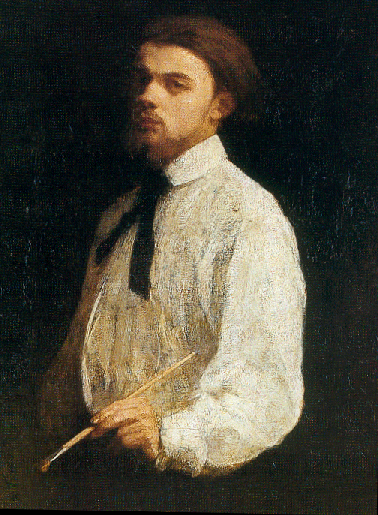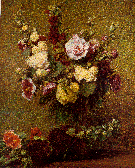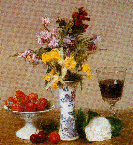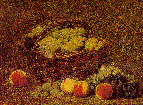Fantin Latour (1836-1904)
Click the thumbnails to see a larger version of each still life image.

You can access some books about Fantin Latour here
Ignace-Henri-Theodore FANTIN-LATOUR
(Quotes from : 'Fantin Latour',by Gustav Kahn , Bodley Head, London, 1927)
"The biography of Fantin- Latour is of a piece, and with- out incident, save for the phases of his aesthetic development."
"He was born at Grenoble on the I4th January 1836 on the second floor of a house in the Cour de Chaulnes. His father, Theodore Fantin-Latour, was born at Metz. He was a painter, and professor of drawing, and sometime copyist at the Louvre, and had married a Russian. The grandfather, Jean-Francois Fantin-Latour, had been a sailor, in the days of the Revolution, and then having been passed into the terri- torial army under the first Empire, rose to Lieut-Colonel in the Artillery. The family was Italian in origin. Fantin was derived from San-Fantino. One Jean Fantin added Latour to the name of Fantin at the end of the XVIIth century."
"Fantin is one of the great flowers-painters. This was not altogether voluntary. The chronology of his work is worth attention as to this. From 1864 to 1896 one finds years when he hardly painted anything but flowers.
It was Whistler who brought Fantin to know Edwin Edwards, a lawyer and an etcher, who developed a deep affection for Fantin, and at a time when French Impressionist painting, or any painting having dealings with the impressionists, was overlooked by the Parisian picture fancier he found him an opening in England. "I am always painting still-life" said Fantin. Those still-lifes went to England."
"Whistler's friendship for him, which brought him the friend- ship of Edwards, also resulted in practical good. Edwards constituted himself his friendly agent in England, and found him admirers and patrons for his flower-paintings and still lifes."
"However, it seems to me that the fundamental influence on Fantin's still lifes, and particularly on the flower-pieces with which we most closely associate him, is none of the artists whom I have so far mentioned, but Titian, who also presides over so many of his figure subjects. If we want to find an equivalent for the texture of Fantin's rose petals, then surely it is conspicuously there in the draperies of a great Titian portrait such as the so-called 'Laura dei Dianti'. Laura's sleeves, her scarf, and the striped costume of her negro page remind us at one and the same time of the way in which Fantin reconciles the need to render texture with the need not to go against the nature of the medium he is using, namely oil paint; and of the way in which he actually constructs, by means of the marks he makes with his brush, the complicated structure of the petals."
(From 'Fantin Latour, Edward Lucie-Smith, Phaidon, Oxford, 1977)







